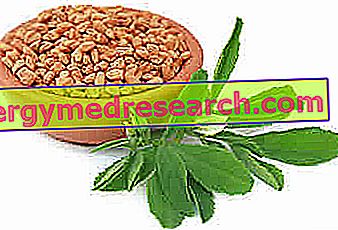Polyunsaturated fats and health
Foods rich in polyunsaturated fats can have positive effects on human health
TO PACT THAT
be consumed with sobriety
and in partial substitution of saturated fats (butter, lard, fatty meats, dairy products) and of hydrogenated ones (margarine, peanut butter).
Polyunsaturated fatty acids can reduce cholesterol levels in the blood and with them the risk of suffering cardiovascular disease.
Ratio Ω6 / Ω3 in some commonly used oils | |
| Linseed oil | 1: 4 |
| Rapeseed oil | 2: 1 |
| Hemp oil | 3: 1 |
| Soybean oil | 8: 1 |
| Olive oil | 9: 1 |
| Wheat germ oil | 10: 1 |
| Peanut oil | 62: 1 |
| Sunflower oil | 71: 1 |
This benefit is mainly ascribed to the omega six, which however - if they are not accompanied by an adequate supply of omega-three - can increase the inflammatory state of the organism and excessively decrease HDL cholesterol. For this reason it is very important to take essential fatty acids in the right proportions. In recent years, this ratio has become significantly unbalanced towards ω-6, in the face of an increasingly poor diet of fish and rich in vegetable oils. All of this to the detriment of our health, since the excess of omega-6 and the omega-3 deficiency increases the "bad" eicosanoids. By itself, therefore, omega-6s are not harmful to human health but, although they perform many essential functions, they can become so when they are consumed in excess of omega-three.
Populations | ω-6 / ω-3 |
Palaeolithic | 0.79 |
Greece before 1960 | 1.00 / 2.00 |
United States 2000 | 16, 74 |
United Kingdom and northern Europe | 15 |
Japan | 4 |
Italy | 13 |
Omega-3 / Omega-6 ratio
The omega-3 / omega-6 ratio is currently around 1:10, when - according to the most modern views - it should be reduced to 1: 2 - 1: 4 (in the diet of our ancient predecessors it was 1: 1) .
From this premise comes the recommendation to consume at least two or three weekly portions of fish.
The omega-three fatty acids associate an important hypo-triglyceridemic activity to the anti-inflammatory function. The positive effect on cholesterol levels is less certain (a possible and slight increase in HDL cholesterol can be registered thanks to the integration of omega-three).
Excess of polyunsaturated fats
Foods rich in polyunsaturated fats are those most prone to rancidity, which is why they must be kept away from light, air and high temperatures. The addition of vitamin E counteracts the phenomena of peroxidation both in food and in the body; its supplementation is therefore appropriate when taking supplements of polyunsaturated fatty acids or foods that contain them in high concentrations. Moreover, oils rich in polyunsaturated fatty acids must be added to the various foods preferably raw and are contraindicated for frying.
Quantity moderation is always a must, since polyunsaturated fats, like the other types, contain nine calories per gram. An excess compared to the needs, therefore, predisposes to overweight and obesity, besides decreasing the coagulation capacity of the blood (exposing the risk of bleeding subjects treated with anti-coagulant drugs).
According to the guidelines for a healthy Italian diet, lipids must represent about 25-30% of daily caloric intake in a balanced diet. About 50% of this quota must be covered by monounsaturated fats (which abound in olive oil), while the remaining part must be more or less equally distributed between saturated fats and polyunsaturated fats.



